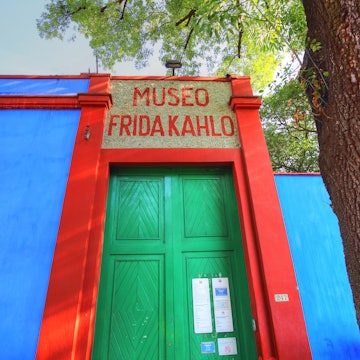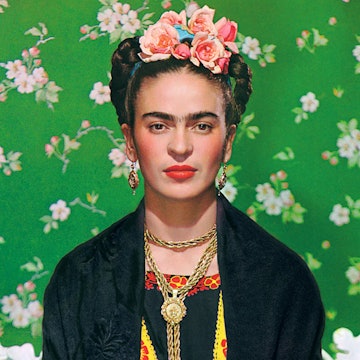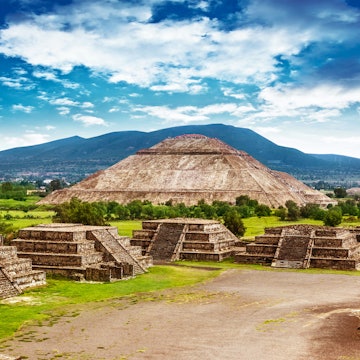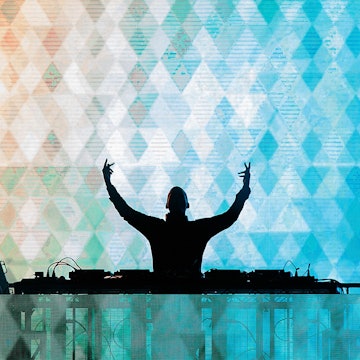

A Dia de Muertos altar in Frida Kahlo's home honors the iconic artist. Seastock / Getty Images
The barrier that separates past and present feels thinner in Mexico City than elsewhere in the world. The dynamic culture of the city, and by extension the country, is constantly evolving while simultaneously reaching back into its tumultuous history.
The art, architecture and cuisine are all inextricably linked to the country’s indigenous roots, colonial influence and modern movement. At the center of this is pop-culture icon and prolific artist, Frida Kahlo, whose work portrays her most intimate self as a symbol of this uniquely Mexican identity.
Discovering the many places in CDMX that formed Frida Kahlo takes the traveler on a journey into the heart of Mexico’s wonderful contradictions and intensely vivid art world and how her legacy continues today.
A past that won’t be denied
The political and cultural center of Mexico City resides in the Zócalo or Plaza de la Constitución. Start your journey there. This colossal city square, surrounded by the National Palace, various government buildings and punctuated by the Catedral Metropolitana was also once the ceremonial center of the Mexica city of Tenochtitlán. Kahlo would have walked through this plaza almost daily on her way to school.
Hernán Cortés tried his best to pick apart the Aztec temples and create New Spain from the bricks, but Templo Mayor, which sits adjacent to the cathedral, would not lie in rest. In the early 1970s, electric workers unearthed a stone disk over 10 feet in diameter carved with the image of Mexica goddess Coyolxauhqui. The discovery of the relief prompted interest in ongoing excavations, and from 1978 to 1982 specialists excavated all of Templo Mayor and recovered over 7,000 Mexica artifacts. Visitors can tour the Templo Mayor site, stand next to various iterations of the temple and see first hand the largesse of a culture that once was and the attempts of another to destroy it.
The Catedral Metropolitana is also not to be missed. The largest cathedral in the Americas, the building was started in 1573 and remained a work in progress during the entire colonial period. The sheer number of architectural styles is impressive, not to mention imagining generations of builders dedicating their lives to creating the most innovative tribute to Catholicism of its day.
With some 82 percent of the population in Mexico claiming Catholicism as a religion, the Templo Mayor and Catedral Metropolitana set the stage for a culture both steeped in indigenous history and practices while remaining dedicated to its colonial influence.
Education through art
Frida Kahlo started secondary school in 1922, not far from the Zócalo. The Antiguo Colegio de San Ildefonso was once home to the National Preparatory School and is just a short walk north of Templo Mayor. Kahlo was one of only 35 girls at a school of 2,000. It is here that Diego Rivera, whom Kahlo would later marry, painted his first mural and launched what was to become Mexico’s world-renown muralist movement.
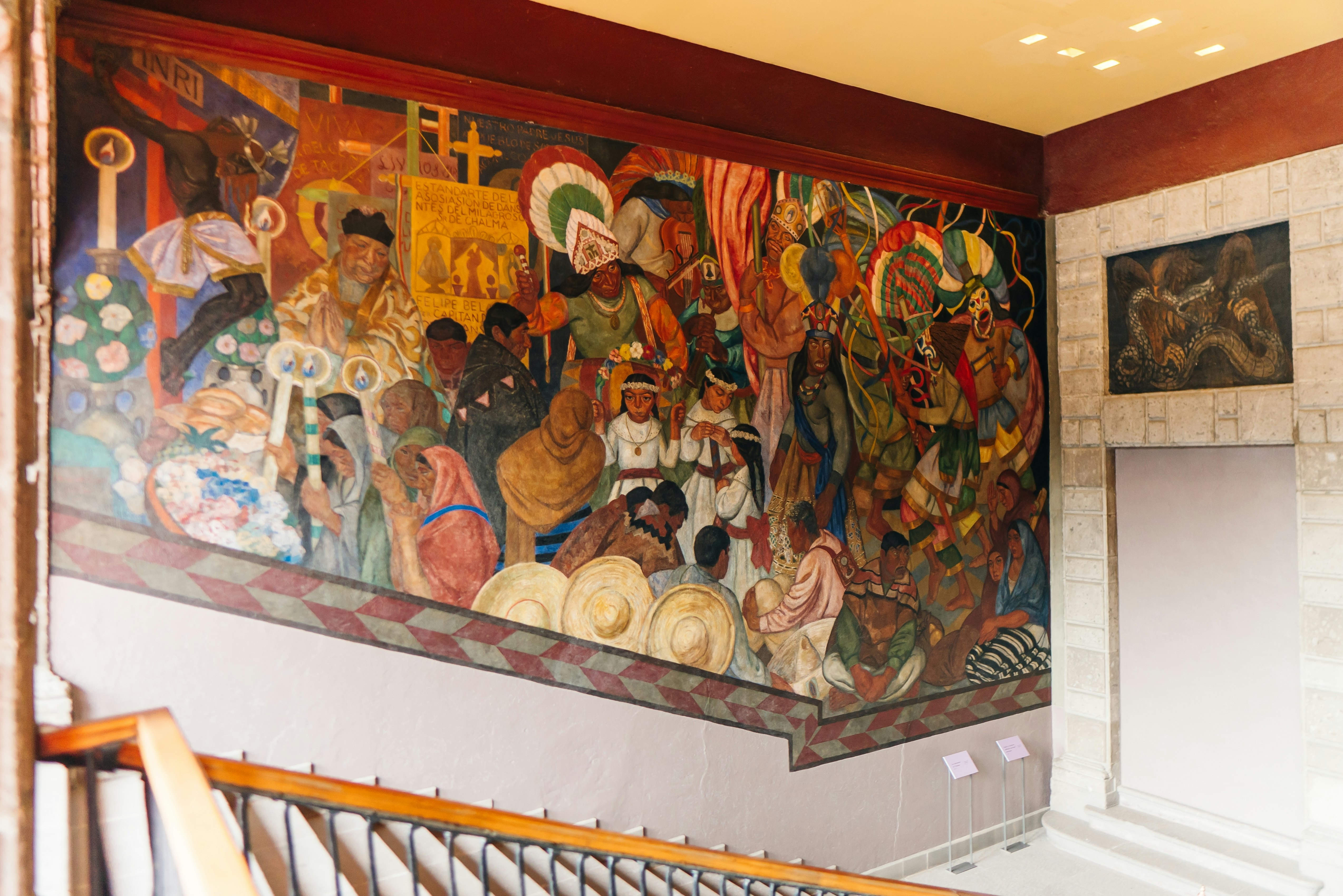
Frida Kahlo watched Rivera compose this first mural dubbed The Creation in a lecture hall of her school. It had been commissioned along with many others by the Mexican government shortly after the Revolution. The aim was to educate the masses, who mostly couldn't read Spanish, with a visual record of history and politics. The Palacio Nacional (National Palace) and Palacio Bellas Artes, in which Kahlo’s body was laid in state after her death, has fantastic examples from Rivera as well as Jose Clemente Orozco and David Alfaro Siqueiros, the other top muralists of the time.
On the way to school in 1925, Kahlo was involved in a horrific trolley accident that left her in a body cast. Forced to lie prostrate for a year, the young Kahlo hung a mirror above her bed and started painting.
Stirrings of an icon
Once Kahlo was able to walk again and had been painting for some time, she brought her paintings to Rivera to ask his opinion of her art. In 1928, he was working on a mural at the Secretaría de Educación Pública which is just a block north of San Ildefonso. Kahlo was 21 when she marched into the master’s workplace to demand a critique of her paintings.
The encounter sparked a romantic relationship and the two were married a year later in Coyoacán. Rivera was 43 and Kahlo 22. Her parents referred to the union as a "marriage between an elephant and a dove."

Coyoacan: The home of a movement
Frida Kahlo spent most of her life living in the Mexico City neighborhood of Coyoacan. Casa Azul, where she was born, grew up and eventually died, is now a museum dedicated to her life and work, Museo Frida Kahlo. A sprawling hacienda painted electric blue, Casa Azul houses everything from Kahlo’s amazing wardrobe to her father’s photography.
Kahlo’s father, Guillermo Kahlo, immigrated from Germany in 1891. Kahlo’s mother, the deeply religious Matilde Calderon y González, was from Oaxaca. Kahlo’s choice of dress was a highly curated part of her creative expression and not typical for women of her station. The Tehuana (traditional dress from the Tehuantepec region in southern Oaxaca) she wore worked to hide her broken body, but also connected her to the indigenous people of Oaxaca, where her mother came from. It was a matriarchal society and thus their traditional dress is considered a symbol of female power and independence.

After getting married, Kahlo and Rivera moved for a brief time to the US. On their return in 1931, the two settled nearby in San Angel at what is now the Museo Casa Estudio Diego Rivera y Frida Kahlo. Designed by their friend, architect and painter Juan O’Gorman, the site boasts three buildings. The first was Diego’s home and studio, which was connected by a rooftop bridge to Frida’s room and studio. A third small structure housed O’Gorman’s home.
Across the street from the museum is the San Angel Inn. Now home to an elegant restaurant that serves classic Mexican cuisine, it was the place where Pancho Villa and Emiliano Zapata agreed to divide control of the country in 1914. It is well worth a stop for mole and a margarita.
Kahlo eventually moved from the home she shared with Rivera back to Casa Azul after their tumultuous relationship grew out of control. The two divorced, but later remarried. They lived in Casa Azul for the remainder of Kahlo's life.
Go to Coyoacan on a Saturday so you can explore some of the best boutiques in the city. Here you will see modern examples of how designers are using traditional styles to create bold and challenging new fashions just as Kahlo did with her style choices all those years ago. Also make a stop at the Bazaar Sábado. Located in Plaza San Jacinto and the adjacent Plaza Tenanitla. Find textiles from Oaxaca along with other regions of Mexico mixed with stunning carvings, incredible jewelry and other wares from artists and artisans throughout the country at this weekly market.
Part of the national fabric
Frida Kahlo’s art combined indigenous symbols with Catholic icons and explored self and country in a way that sought to define a Mexican identity. Her self-portraits mimic those popular in the colonial era, but subvert the form by including surreal elements and making herself less attractive. She was influenced both by classically trained artists and Mexican folk artists, creating a piece of Mexicanidad (romantic nationalism movement) that persists to this day.

Fast forward 64 years since Kahlo’s death and her hometown is booming with art, design and cuisine that, like Kahlo, pay homage to Mexico’s confusing and complicated history while keeping a firm eye on shaping the future.
Check out the art galleries in Roma and then head to Polanco for Museo Soumaya, a modernist building designed by Mexican architect Fernando Romero that literally glistens in the high-altitude sun. Inside, the sleek minimalist galleries highlight the stunning art collection of Mexican businessman and avid collector Carlos Slim. The museum is free because Slim believes that all Mexican people should have access to art. The collection is broad, including works from pre-columbian artisans, European masters and modern creators.
https://shop.lonelyplanet.com/products/lonely-planets-best-in-travel-paperback-2019











